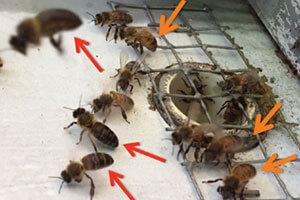
When walking up to an apiary, a good beekeeping skill is to let your vision sweep across the hives seeing how the bees flow through the air. When bees are making honey, the bee traffic should stream from the entrances up into the sky or over into nearby fields. The apiary flight pattern is similar in a Summer dearth, except fewer bees fly and many of those haul water for cooling the hives.
A deviation from the normal flight pattern can sometimes indicate a problem. The Summer dearth had begun when I entered my home research apiary one morning. Immediately, I saw bees searching around the backs of the hives, flying low to the ground, not normal at all. Most likely those were bees newly initiated to rob honey, still searching for a source. So I searched too. Everything appeared normal around the large hives. I also have observation hives in a bee house, which can hold up to 30 of these single-comb colonies. The bee flight looked normal from all of them–except one. From that hive, bees were leaving with loaded abdomens (see Figure 1). All else seemed superficially normal. No bees were fighting.
By now, I knew what was occurring, but I had never seen it in an observation hive. This opportunity was my first to see the inner workings of the honey robbing that would leave the colony to starve. On the honey band across the comb, some of the bees were chewing through the caps. They were intent on removing all the honey. While other bees moved around them, these bees remained mostly still loading up on honey (see Figure 2). I knew these had to be the same bees leaving with the full abdomens.
This condition is called progressive robbing, which is different from mass robbing. Mass robbing has clouds of excited bees in the air. Bees fight at the hive entrance and they are prone to sting. Progressive robbing lacks that mayhem, and is subtler, calling one to look for little details to detect its destruction.
Here are a couple of situations where I have seen progressive robbing occur. Sometimes after robber bees have entered a defending colony numerous times, maybe starting out as mass robbing, they do not hesitate anymore. They do not show the characteristic robber bee zig-zag flight behavior. Instead, they enter the defending colony almost as if they were members of that colony (nest mates). In this case, the robber bees are difficult to distinguish from the defending bees. In the second case, the guard bees prevent most but not all robber bees from entering the hive. The robber bees constantly harass the guard bees and occasionally some manage to evade the guard bees and enter the hive. The first case shows no guarding “resistance” to the robbing, while the second case shows some resistance, and gives a noticeable symptom. (In both cases, the robber bees may appear more hairless and somewhat shiny, but do not depend on this appearance in any…


